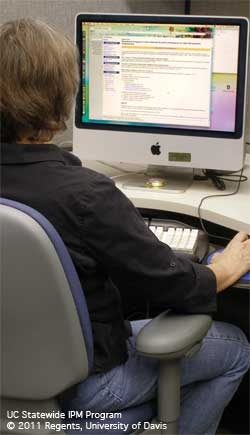
Posts Tagged: DPR
Diagnosing Herbicide Injury- New Online Course
Written By--Petr Kosina, UC Statewide IPM Program A brand-new online course on Diagnosing Herbicide Injury focusing on how an herbicide injury situation can arise, what information can help diagnose symptoms during field...
UC IPM online courses offer continuing education units. Nov. 19 deadline coming.
—Cheryl Reynolds, UC Statewide IPM Program
Are you looking for continuing education units (CEUs) to complete your renewal application this year for the Department of Pesticide Regulation (DPR)? The UC Statewide IPM Program has several online courses available that can help you get those last few needed credits.
DPR license and certificate holders with last names beginning with M – Z renew this year. Renewal packets must be submitted to DPR before November 19th to ensure that licenses are renewed by January 1, 2016. After that, applications may take up to 45 calendar days to process.
The online courses available from UC IPM that offer units for DPR license renewal include:
- Providing Integrated Pest Management Services in Schools and Child Care Settings (1 unit Laws and Regulations and 1 unit Other)
- Pesticide Resistance (2 units Other)
- Pesticide Application Equipment and Calibration (1.5 units Other)
- IPM – A Solution for Reducing Pesticides/Water Quality: Pesticide Properties (1 unit Other)
- The Impact of Pesticides on Water Quality/Mitigating Urban Pesticide Runoff (1 unit Other)
- Water Quality and Mitigation: Bifenthrin and Fipronil (1 unit Other)
- Herbicides and Water Quality (1 unit Other)
CEUs from the Structural Pest Control Board are also available for most of these courses.
For a list of other approved online or in-person courses, visit the DPR website. UC IPM plans to add additional online courses for 2016, including those available for Laws and Regulations units. For more information about the courses UC IPM offers as well as additional training opportunities and pest management information, see the UC IPM web site.

IPM computertraining
New Reference Booklet Available for Pesticide Applicators: Understanding Pesticide Labels for Making Proper Applications
The UC Statewide Integrated Pest Management Program (UC IPM) put together a 26-page card set in English and Spanish on understanding pesticide labels. Intended for pesticide handlers, applicators, safety trainers, and pest control advisers (PCAs), the cards explain when to read the label, describe what kind of information can be found in each section of a pesticide label, and point out specific instruction areas so that applicators can apply pesticides safely and avoid illegal pesticide residues.
Traces of pesticide residue are normal and even expected after pesticides are applied to food crops, but by the time produce is ready to be sold, purchased, and consumed, residues are usually far below the legal limit.
by Cheryl Reynolds, UC Statewide IPM Program
In its latest report from 2013, the California Department of Pesticide Regulation (DPR) reported that there was little or no detectable pesticide residue in 97.8% of all California-grown produce. This demonstrates a strong pesticide regulation program and pesticide applicators that apply pesticides safely and legally. However, there have been instances in California where a pesticide not registered for a specific crop has been used unintentionally, resulting in illegal residues and eventually crop loss and destruction.
The Environmental Protection Agency (EPA) sets tolerances for the maximum amount of pesticide residue that can legally be allowed to remain on or in food.
DPR regularly monitors domestic and imported produce for pesticide residues and is considered the most extensive state residue-monitoring program in the nation.
The primary way pesticide applicators can assure that they make proper applications and avoid illegal pesticide residues is to follow the pesticide label. UC IPM's new card set was developed from information in the upcoming third edition of The Safe and Effective Use of Pesticides as well as Lisa Blecker, UC IPM's Pesticide Safety Education Program coordinator. Bound with a spiral coil, this eye-catching instructional card set was designed for both English-speakers and when flipped over, for Spanish-speaking audiences as well. UC IPM also plans to release a new online course on preventing illegal pesticide residues sometime late fall.
To download copies of the card set in English or in Spanish, see the UC IPM web site.

IPM labels
Online IPM Training for PCAs and Growers Which Can Earn Continuing Education Credits
Statewide IPM Program staff members work closely with area IPM advisors, farm advisors, specialists, and researchers to develop educational programs that reflect the newest advances in pest management.
These online courses are FREE. Additional training materials, including videos, DVDs, books, and leaflets, are available in the Publications section. Check the Workshops & Events page for in-person presentations and hands-on training opportunities. Many of these training materials can gain Continuing Education Credits through, such organization as the Department of Pesticide Regulation, the Structural Pest Control Board or provide a Certificate of Completion from the University of California.
All of UC IPM's current online training courses can be found here:
http://www.ipm.ucdavis.edu/training/
More training courses are planned in the future.
In addition to the courses, a number of videos have been created over the years, most of which are short and posted on UC IPM's YouTube channel https://www.youtube.com/user/UCIPM/videos/
You can also find these plus additional videos organized by Ag, Urban, and Spanish on the video library on our web site
http://www.ipm.ucdavis.edu/IPMPROJECT/videolibrary.html
The videos don't allow for CEUs, but they can be useful as part of training and learning activities.

IPM computertraining
